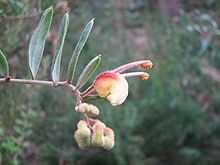- Grevillea celata
-
Nowa Nowa Grevillea 
Conservation status Scientific classification Kingdom: Plantae (unranked): Angiosperms (unranked): Eudicots Order: Proteales Family: Proteaceae Genus: Grevillea Species: G. celata Binomial name Grevillea celata
Molyneux[1]Synonyms Grevillea aff. chrysophaea (Nowa Nowa)
Grevillea celata (Nowa Nowa Grevillea or Colquhoun Grevillea) is a shrub which is endemic to Victoria, Australia.[2] It is closely related to Grevillea alpina and Grevillea chrysophaea.
It grows to between 0.4 to 1.8 metres in height.[2] The undivided leaves are tomentose underneath and are 20 to 45 mm long and 4 to 18 mm wide.[2] The leaf margins are recurved, sometimes to the extent of being near-revolute..[2] Flowers appear between July and February (mid winter to late summer) in its native range.[2] These have perianths which are red at the base and yellow at the top, or alternatively red/white, apricot/white or occasionally all yellow. The styles are green at the base, becoming pink or red towards the tip, with the tip itself being green. Occasionally these are completely light green in colour.
The species was first formally described by Bill Molyneux in Muelleria in 1995.[1]
G. celata occurs in dry, sclerophyll woodland in Colquhoun State Forest in south-eastern Victoria.[2]
The species is listed as "Vulnerable" under the Environment Protection and Biodiversity Conservation Act, "threatened" in Victoria under the Flora and Fauna Guarantee Act 1988 and "Vulnerable in Victoria" on the Department of Sustainability and Environment's Advisory List of Rare Or Threatened Plants In Victoria.[3][4]
References
- ^ a b "Grevillea celata". Australian Plant Name Index (APNI), IBIS database. Centre for Plant Biodiversity Research, Australian Government. http://www.anbg.gov.au/cgi-bin/apni?taxon_id=219377.
- ^ a b c d e f "Grevillea celata". Flora of Australia Online. Department of the Environment and Heritage, Australian Government. http://www.anbg.gov.au/abrs/online-resources/flora/stddisplay.xsql?pnid=45595.
- ^ "Threatened List October 2010". Flora and Fauna Guarantee Act 1988. Department of Sustainability and Environment. http://www.dse.vic.gov.au/DSE/nrenpa.nsf/LinkView/EADA0F1874AF9CF24A2567C1001020A388BBA5581CF9D859CA256BB300271BDB. Retrieved 2010-11-09.
- ^ "Advisory List of Rare Or Threatened Plants In Victoria - 2005". Department of Sustainability and Environment (Victoria). http://www.dse.vic.gov.au/dse/nrenpa.nsf/LinkView/996B0477753A4204CA256DD4007F1CA528E305DE442CAC684A256DEA0024ACF6. Retrieved 2010-11-09.
Categories:- EPBC Act vulnerable biota
- Grevillea
- Flora of Victoria (Australia)
- Proteales of Australia
- Proteaceae stubs
- Australian eudicot stubs
Wikimedia Foundation. 2010.

